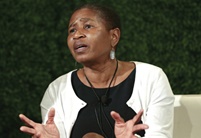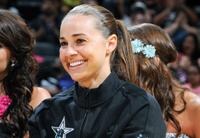As an impressive array of sports leaders gathers for the second annual Game Changers Conference this week, let’s reflect on how far we have come this year and how far we have to go to achieve any form of gender equity in sport.
I was a speaker at last year’s Game Changers Conference and was heartened by how many people turned out on the occasion of the first SportsBusiness Journal conference on gender. There was an array of informative and inspirational speakers and an audience full of people whose status made them able to be game changers then and in the future.
However, I will always remember the remarks of two men who spoke. One noted that the progress for women was being measured by the increasing number of bathrooms in the new stadiums and arenas. The other noted that there is more healthy food on the concourses.
Some men just don’t get it. It’s about more women becoming decision-makers in our front offices, league offices and in college athletics departments. It’s about more women columnists and editors of our publications and websites. It’s about more women heading up agencies working in the world of sports. It’s about real opportunity based on talent and not gender.
 |
|
 |
Michele Roberts, Becky Hammon: Women making inroads in men’s professional basketball.
Photo by: GETTY IMAGES; NBAE / GETTY IMAGES
|
There has been good news this year. Michele Roberts is the new executive director of the National Basketball Players Association, and Becky Hammon became an assistant coach on the NBA champion San Antonio Spurs.
After we published the College Racial and Gender Report Card last year, I was engaged on Twitter by feminist scholar and activist Molly Arenberg, who wondered why I wasn’t grading men’s sports teams for gender hiring. She struck a chord, and this year for the first time in the College RGRC we did just that. Her intervention has led me to now ask college athletic directors, “Would you consider hiring a woman as a head coach of the men’s team or as assistant coach of the men’s team?” The looks I get are perplexed at best. Yet when I point out to them that more than 60 percent of our women’s teams across all three divisions in college sports are coached by men and more than 50 percent of the assistant coaches of women’s teams are men, the conversation usually ends awkwardly.
Now we have to ask the question, Why aren’t there more women coaching men’s teams? Why aren’t we considering more women as CEOs, general managers and top executives on pro teams in men’s sports?
I have been writing racial and gender report cards since the late 1980s. My intention has always been to put the spotlight on our sports teams and universities to hire more women and people of color as coaches and in decision-making positions. Shame on me and others for not asking why we were not hiring women in all top sports operations positions on men’s professional teams and on men’s college teams. It is scandalous that 42 years after the passage of Title IX that we have fewer than 40 percent of women’s college teams coached by women and fewer than 50 percent of the assistant coaches on women’s teams who are women. It doesn’t make sense.
And the men running the show are, not surprisingly, almost all white. In the most recent College RGRC published last month, all Football Bowl Subdivision conference commissioners were white men. The percentage of whites holding the position of athletic director in 2012-13 was overwhelming — at 87 percent, 92 percent and 94 percent in Divisions I, II, and III, respectively. A mere 8.6 percent of Division I athletic directors were women.
Whom do they hire as coaches?
Whites dominate the head coaching ranks on men’s teams, holding 86 percent, 88 percent and 92 percent of all head coaching positions in Divisions I, II, and III, respectively. On the women’s teams, whites held 85 percent, 88 percent and 92 percent of all head coaching positions in Divisions I, II, and III. Again, fewer than 40 percent were women.
Whom do they hire in the other senior positions in college athletics?
White women continued to dominate the senior woman administrator position, holding 83 percent, 88 percent and 93 percent in Divisions I, II, and III.
The sports information director influences which athletes and coaches will get the media coverage. The SID is overwhelmingly white in all three divisions with 95 percent, 92 percent and 97 percent of the SID positions in Division I, II, and III, respectively. Women held 13 percent, 10 percent and 13 percent of the SID positions, respectively.
A recent report from the Tucker Center for Research on Girls & Women in Sport showed that while “40 percent of all sports participants are female, they receive just 2-4 percent of all coverage and the emphasis is on their femininity vs. their athletic competence.”
All of this is completely unacceptable.
So Game Changers, let’s ask the tough questions and keep the pressure on so that we can make more progress until we finally get equality in sports. Isn’t that what we all say we have been seeking?
I tip my hat to Arenberg for helping me to realize what needed to be done a long time ago.
Richard E. Lapchick (rlapchick@ucf.edu) is the director of the Institute for Diversity and Ethics in Sport at the University of Central Florida, which annually publishes racial and gender report cards on MLB, the NBA and WNBA, NFL, MLS, college sports, and the APSE. Follow him on Twitter @richardlapchick and on Facebook at facebook.com/richard.lapchick.






